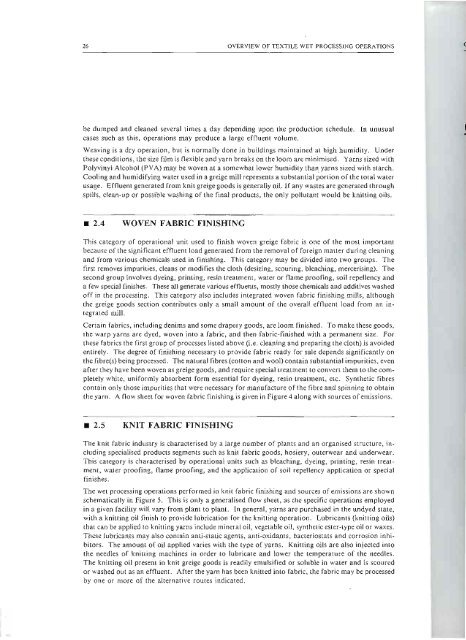Contributor, The Textile Industry and the Environment, UNEP
Contributor, The Textile Industry and the Environment, UNEP
Contributor, The Textile Industry and the Environment, UNEP
You also want an ePaper? Increase the reach of your titles
YUMPU automatically turns print PDFs into web optimized ePapers that Google loves.
26 OVERVIEW OF TEXTILE WET PROCESSING OPERATIONS<br />
be dumped <strong>and</strong> cleaned several times a day depending upon <strong>the</strong> production schedule. In unusual<br />
cases such as this, operations may produce a large efnuent volume.<br />
Weaving is a dry operation, but is normally done in buildings maintained at high humidity. Under<br />
<strong>the</strong>se conditions, <strong>the</strong> size film is flexible <strong>and</strong> yarn breaks on <strong>the</strong> loom are minimised. Yarns sized with<br />
Polyvinyl Alcohol (PVA) may be woven at a somewhat lower humidity than yarns sized with starch.<br />
Cooling <strong>and</strong> humidifying water used in a greige mill represents a substantial portion of <strong>the</strong> total water<br />
usage. Effluent generated from knit greige goods is generally nil. Ifany wastes are generated through<br />
spills, clean-up Of possible washing of <strong>the</strong> final products, <strong>the</strong> only pollutant would be knitting oils.<br />
• 2.4 WOVEN FABRIC FINISHING<br />
This category of operational unit used to finish woven greige fabric is one of <strong>the</strong> most important<br />
because of <strong>the</strong> significant effluent load generated [rom <strong>the</strong> removal of foreign matter during cleaning<br />
<strong>and</strong> from various chemicals used in finishing. This category may be divided into two groups. <strong>The</strong><br />
firs! removes impurities, cleans or modi fies <strong>the</strong> cloth (desizing, scouring, bleaching, mercerising). <strong>The</strong><br />
second group involves dyeing, printing, resin treatment, water or flame proofing, soil repellency <strong>and</strong><br />
a few special finishes. <strong>The</strong>se all generate various effluents, mostly those chemicals <strong>and</strong> additives washed<br />
off in <strong>the</strong> processing. This category also includes integrated woven fabric finishing mills, although<br />
<strong>the</strong> greige goods section contributes only a small amount of <strong>the</strong> overall effluent load from an integrated<br />
mill.<br />
Certain fabrics, including denims <strong>and</strong> some drapery goods, are loom finished. To make <strong>the</strong>se goods,<br />
<strong>the</strong> warp yarns are dyed, woven into a fabric, <strong>and</strong> <strong>the</strong>n fabric-finished with a permanent size. For<br />
<strong>the</strong>se fabrics <strong>the</strong> first group of processes listed above (i.e. cleaning <strong>and</strong> preparing <strong>the</strong> cloth) is avoided<br />
entirely. <strong>The</strong> degree of finishing necessary to provide fabric ready for sale depends significantly on<br />
<strong>the</strong> fibre(s) being processed. <strong>The</strong> natural fibres (cotton <strong>and</strong> wool) contain substantial impurities, even<br />
after <strong>the</strong>y have been woven as greige goods, <strong>and</strong> require special treatment to convert <strong>the</strong>m to <strong>the</strong> completely<br />
white, uniformly absorbent form essential for dyeing, resin treatment, etc. Syn<strong>the</strong>tic fibres<br />
contain only those impurities that were necessary for manufacture of <strong>the</strong> fibre <strong>and</strong> spinning to obtain<br />
<strong>the</strong> yarn. A now sheet for woven fabric finishing is given in Figure 4 along with sources ofemissions.<br />
• 2.5 KNIT FABRIC FINISHING<br />
<strong>The</strong> knit fabric industry is characterised by a large number of plants <strong>and</strong> an organised structure, including<br />
specialised products segments such as knit fabric goods, hosiery, outerwear <strong>and</strong> underwear.<br />
This categOry is characterised by operational units such as bleaching, dyeing, printing, resin treatment,<br />
waler proofing, name proofing, <strong>and</strong> <strong>the</strong> application of soil repellency application or special<br />
finishes.<br />
<strong>The</strong> wet processing operations performed in knit fabric finishing <strong>and</strong> sources of emissions are shown<br />
schematically in Figure 5. This is only a generalised flow sheet, as <strong>the</strong> specific operations employed<br />
in a given facility will vary from plant to plant. In general, yaros are purchased in <strong>the</strong> undyed state,<br />
with a knitting oil finish to provide lubrication for <strong>the</strong> knitting operation. Lubricants (knitting oils)<br />
that can be applied to knitting yarns include mineral oil, vegetable oil, syn<strong>the</strong>tic ester-type oil or waxes.<br />
<strong>The</strong>se lubrican.ts may also contain anti-static agents, anti-oxidants, bacteriostats <strong>and</strong> corrosion inhibitors.<br />
<strong>The</strong> amount of oil applied varies with <strong>the</strong> type of yarns. Knitting oils are also injected into<br />
<strong>the</strong> needles of knitting machines in order to lubricate <strong>and</strong> lower <strong>the</strong> temperature of <strong>the</strong> needles.<br />
<strong>The</strong> knitting oil present in knit greige goods is readily emulsified or soluble in water <strong>and</strong> is scoured<br />
or washed out as an effluent. After <strong>the</strong> yarn has been knitted inlo fabric, <strong>the</strong> fabric may be processed<br />
by one or more of <strong>the</strong> alternative routes indicated.<br />
(

















